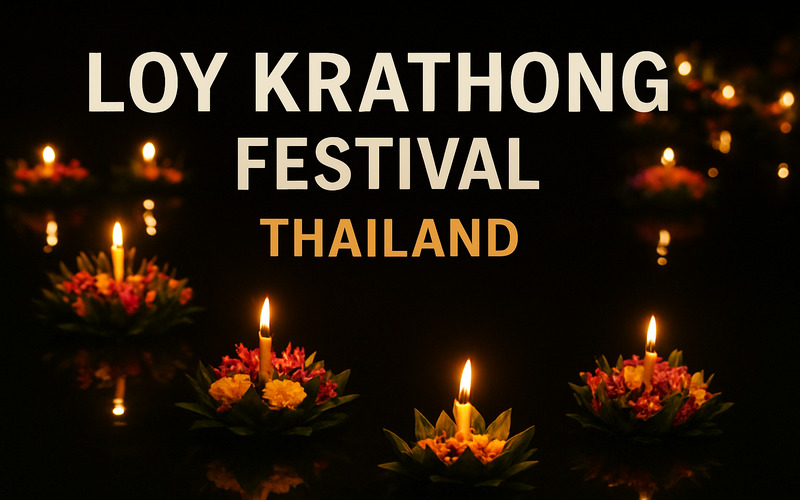
Every November, as the full moon rises over Thailand, the country glows with the soft light of thousands of floating lanterns. Loy Krathong Festival is a magical celebration of gratitude, renewal, and beauty — where locals and visitors alike release krathongs onto rivers and lakes to let go of misfortunes and welcome new blessings. Whether you’re wandering through Chiang Mai’s lively streets, the ancient ruins of Sukhothai, or along Bangkok’s riverside, Loy Krathong invites you to experience Thailand’s culture at its most peaceful and enchanting. Join us at IDC Travel and make this magical festival a part of your journey through Thailand!
Origin & Meaning of Loy Krathong Festival
Name & Meaning
- “Loy” (ลอย) in Thai means “to float” or “to drift.”
- “Krathong” (กระทง) refers to a small floating vessel or raft, traditionally made of banana leaves, decorated with flowers, candles, and incense sticks.
When combined, “Loy Krathong” can be translated as “floating a light raft on the water.”
Origins and Legends
Thais say that the Loy Krathong Festival began during the Sukhothai Kingdom in the 13th century. According to legend, royal ladies crafted banana leaf boats shaped like lotus flowers, adorned them with flowers and candles, and set them afloat as a way to express gratitude to the Buddha and the river that sustains life. The king was so moved that he decreed the tradition to be observed annually on the full moon of the 12th lunar month — a gesture of gratitude to nature and a wish for peace and prosperity.
Others offer a simpler explanation: this 700-year-old festival is a time to apologize to and thank the Water Goddess, Phra Mae Khongkha, while symbolically letting go of misfortune. Thais believe that when a krathong floats away, so do bad luck and sorrow, leaving space for new blessings.
Another legend attributes the festival to Nang Nopphamat, a royal consort during the Sukhothai period in the 14th century, who crafted the first beautifully decorated krathong as an offering to the king and the river on a full moon night. The ritual spread across the kingdom and became an essential part of Thai spiritual life.
The Cultural Soul of the Festival
Loy Krathong is more than just a festival of light and water — it is a time for people to reconnect with nature, express gratitude, let go of the old, and welcome new beginnings. Its spirit lies in tranquility, renewal, and mindfulness, making it one of Thailand’s most meaningful and unforgettable cultural experiences.
Time & Location of Loy Krathong Festival
Time
Loy Krathong takes place on the night of the full moon in the 12th lunar month of the Thai calendar, usually in November. In 2025, the festival is expected to fall on the evening of November 6th.
Festivities typically start at sunset and continue late into the night. As darkness falls, thousands of candlelit krathongs reflect on the water, blending with city lights and traditional music — creating a magical scene you’ll never forget.
In some places, the festival lasts only one night, but in Chiang Mai, it extends for 2–3 days with parades, performances, and grand lantern competitions.
Major Festival Locations, Highlights & Differences
1. Chiang Mai
If you’ve ever seen images of thousands of sky lanterns rising together into the night — that’s Chiang Mai! The city hosts Loy Krathong alongside the Yi Peng Festival, creating Thailand’s most spectacular light show.
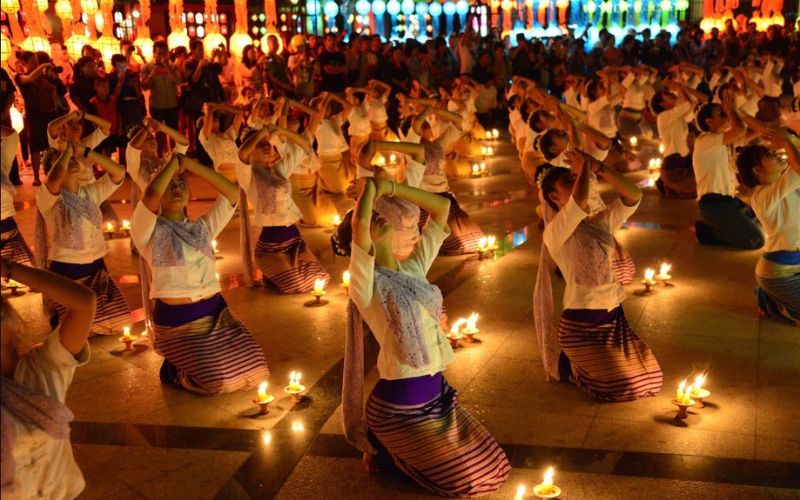
Graceful Thai dancers perform a candlelit ritual during the Loy Krathong Festival.
- Main Venues: Tha Phae Gate, Nawarat Bridge, Ping River, Old City area.
- Duration: 3–5 days, centered around the full moon night.
- Entry: Free in public areas; sky lantern events charge 1,000–3,000 baht.
- Best for: Those who love vibrant festivals and large crowds.
- A little tip from us: if you want to capture the best photos and avoid the crowds, try to arrive at the riverside as early as possible. The anticipation in the air is also part of the festival’s charm! Chiang Mai is a fusion of light, music, and joy — stroll through night markets, try Northern Thai dishes, and enjoy the illuminated parades.
2. Sukhothai
Regarded as the birthplace of Loy Krathong, Sukhothai offers a more spiritual and historical atmosphere. When candlelight reflects off the temple ruins and lakes, it feels as if you’ve stepped back in time.
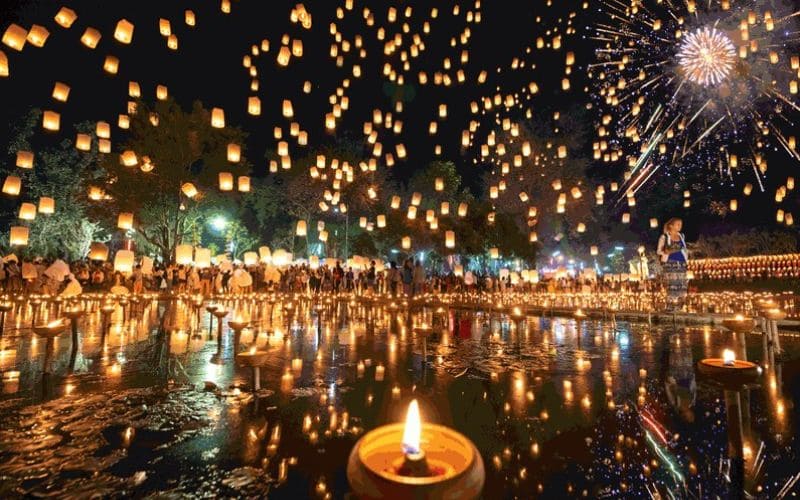
The night sky of Thailand glows with thousands of floating lanterns during the Loy Krathong Festival.
- Main Venue: Sukhothai Historical Park.
- Duration: 5–7 days, featuring traditional dance, music, and nightly fireworks.
- Entry: 100–300 baht.
- Best for: Culture lovers and those seeking a serene experience.
- A little tip from us: Sit quietly on a boat at Wat Mahathat, watching your krathong drift under the candlelight — it’s deeply peaceful and emotional.
3. Bangkok
In the capital, Loy Krathong combines modern style with Thai tradition.
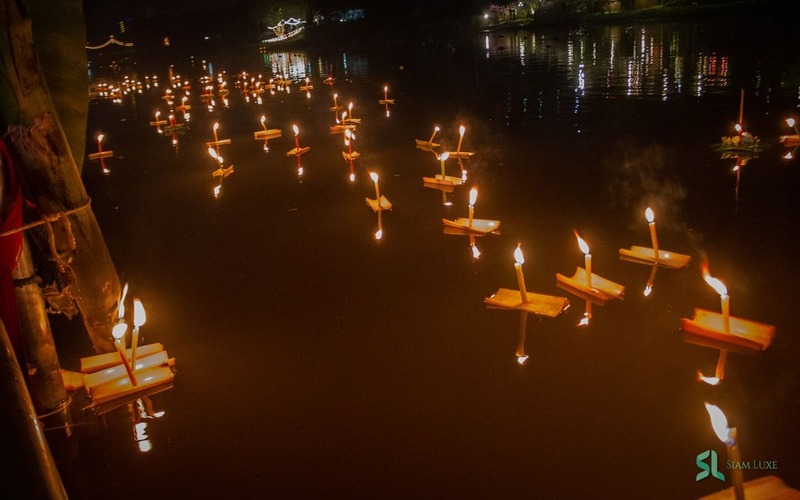
Wooden Krathongs carrying flickering candles drift along the quiet river.
- Main Venues: Along the Chao Phraya River — Asiatique, Iconsiam, Rama VIII Bridge.
- Duration: 1–2 days.
- Entry: Free; river cruise dinners cost 1,000–5,000 baht.
- Best for: Those who enjoy comfort, convenience, and a touch of luxury.
Our Tip
Because Bangkok is a bustling city and it gets even more crowded during festivals. So, we’d like to share some useful information about transportation options in Bangkok to help make your experience smoother and more enjoyable.
- BTS Skytrain (Most Convenient: fast, affordable, best way to avoid Bangkok’s traffic)
- To ICONSIAM: Take the BTS Silom Line and get off at Saphan Taksin Station (S6), about 40-50 baht/person/trip. Exit toward Sathon Pier (Central Pier), located just below the station. From there, board the free ICONSIAM Shuttle Boat, available every 10–15 minutes between 9:00 AM and 10:00 PM. The scenic ride takes about 10 minutes and offers beautiful views of the Chao Phraya River.
- To Asiatique The Riverfront: Follow the same route to Saphan Taksin Station (S6). From Sathon Pier, take the free Asiatique Shuttle Boat, departing every 15 minutes from 4:00 PM to 11:30 PM. The trip lasts about 10 minutes. It’s best to go around sunset — the light over the river is stunning.
- MRT Subway (quick and comfortable): If you’re staying near an MRT Blue Line station, ride to Hua Lamphong Station, then transfer to the BTS Silom Line at Sala Daeng Station. Continue to Saphan Taksin Station, then catch the shuttle boat to either ICONSIAM or Asiatique. The whole trip usually costs around 40–60 baht.
- Taxi, Grab, or Bolt: Taking a taxi or ride-hailing app is the easiest door-to-door option, though traffic can be heavy during 4:30–7:30 PM.
- From Siam to ICONSIAM, expect to pay around 120–160 baht.
- From Siam to Asiatique, about 130–170 baht.
Using Grab or Bolt helps ensure fair pricing. If you’re traveling with three or four people, this option can actually be cheaper than BTS tickets combined. Avoid tuk-tuks for longer rides — they often cost more than taxis despite the fun experience.
Our Extra Tips
- At Saphan Taksin Pier, follow the “Free Shuttle Boat” signs — staff are friendly and always ready to assist.
- If you want to enjoy the night view of the Chao Phraya River, consider booking a dinner cruise departing from ICONSIAM or Asiatique around 7:30–8:00 PM.
- Keep some cash or a Rabbit Card handy for BTS or MRT rides.
4. Ayutthaya
As Thailand’s ancient capital, Ayutthaya offers a nostalgic and romantic ambiance.
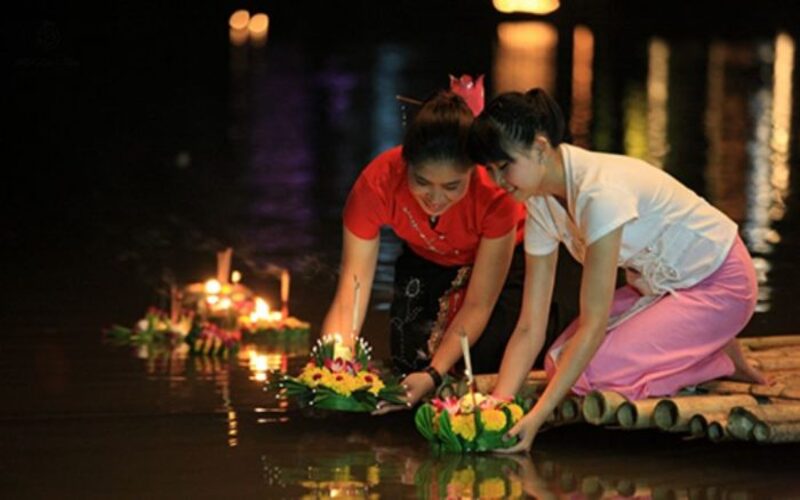
Two Thai women float their Krathongs under the shimmering night sky.
- Main Venues: Bang Sai Arts & Crafts Centre, Ayutthaya Historical Park.
- Duration: 2–3 days.
- Entry: Mostly free.
- Best for: Photography enthusiasts and culture lovers.
- A little tip from us: Just 1.5 hours from Bangkok, Ayutthaya makes a perfect short trip. The festival recreates royal court traditions under candlelight among ancient ruins — less crowded and wonderfully atmospheric.
5. Coastal Cities (Phuket, Pattaya, Hua Hin, etc)
If you prefer a more relaxed, romantic celebration by the sea, this is for you.
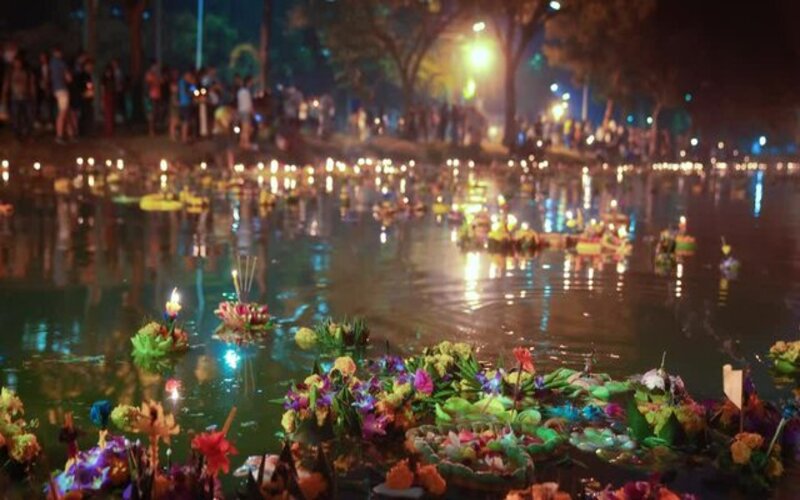
The river sparkles with hundreds of glowing Krathongs.
- Main Venues: Patong (Phuket), Jomtien (Pattaya), Hua Hin beach.
- Duration: 1–2 days.
- Best for: Couples, friends, and beach lovers.
- A little tip from us: Check the weather in advance — wind or tides may affect lantern floating. Instead of rivers, krathongs are set afloat directly into the sea, under moonlight and soft waves, often accompanied by seafood feasts, music, and night markets.
>>>Don’t just admire Loy Krathong through photos — come and experience its magic in person with Thailand 8 Days Tour to Bangkok & Chiang Mai
Floating Lanterns (Krathong) — Craft & Meaning
How to Get a Krathong
You can buy one at riverside stalls for 20–30 baht, or join a krathong-making workshop for a hands-on experience. A traditional Krathong is shaped like a lotus flower, symbolizing purity and enlightenment. Each one usually contains three incense sticks, a candle, a few fresh flowers, and sometimes a small coin to send prayers and wishes.
Decoration
If you want to decorate your own Krathong to make it truly stunning, based on our experience, we recommend using banana leaves folded into flower petals or decorating it with fresh flowers such as lotus, jasmine, or chrysanthemum.
You can cut the banana leaves into triangle shapes, then fold and curve them to resemble lotus or chrysanthemum petals. After that, glue or pin them around the base to form a floral circle. It is said that this style of decoration symbolizes purity and a sincere heart offered to the Goddess of Water.
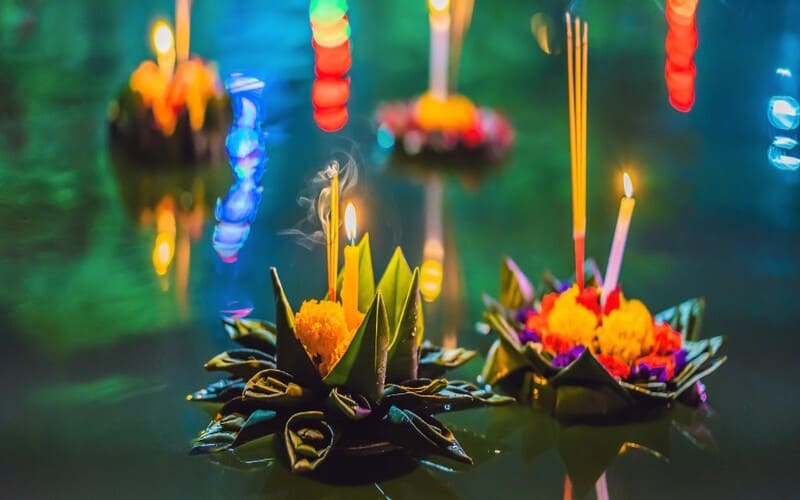
Each Krathong is carefully crafted from banana leaves, fresh flowers, candles, and incense.
If you prefer not to use banana leaves, try using fresh flower petals instead — glue or pin them around the base to create a colorful floral wreath. It’s best to choose flowers with bright, vivid colors so your Krathong stands out beautifully when floating on the river at night. A Krathong made of fresh flowers looks natural, radiant, and almost magical — like a tiny star shining brightly, spreading blessings to everyone.
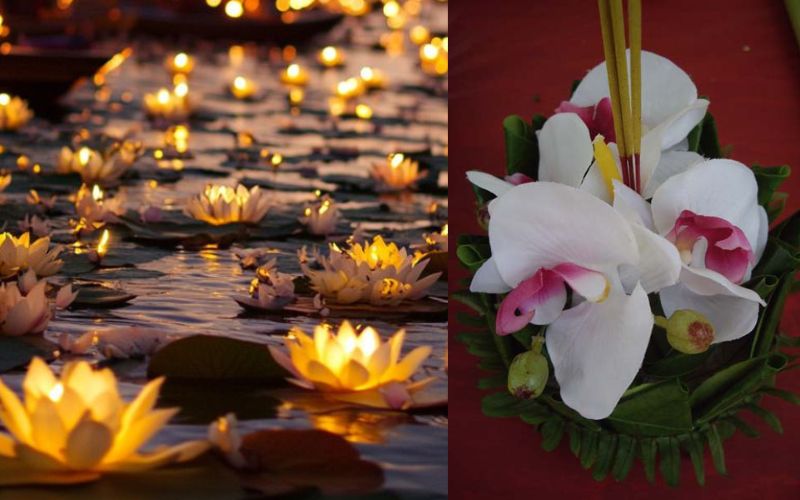
Each Krathong carries a heartfelt prayer.
To easily create your very own Krathong, we recommend joining a Krathong-making workshop guided by local Thai artisans. Here are some websites offering such workshops:
-
Thai Secret Cooking School – offers a Krathong-making workshop combined with a Thai cooking class in Chiang Mai.
-
Mahidol University International College – hosts workshops teaching how to make Krathongs from banana leaves and flowers.
-
PSUIC Hat Yai Campus – organizes Krathong-making workshops for students and staff.
-
ASB Sukhumvit – runs “Krathong Making Activities” for students and teachers at the XCL American School of Bangkok.
Meaning of Floating a Krathong
- To wish for peace and good fortune in the coming year.
- To release mistakes and misfortunes.
- To express gratitude to the water — the source of life.
- If the candle remains lit as your krathong drifts away, it’s a sign of good luck ahead.
>>>Ready to experience the beauty of Thailand? Book Signature Thailand in 20 Days: Culture, Coastlines and Hidden Gems today and join us for a night of floating lanterns and glowing Krathongs!
Highlight Activities & Experiences at Loy Krathong Festival
Loy Krathong isn’t just visually stunning — it’s an emotional and cultural journey where you can both participate and connect with Thailand’s heart. Here are the top experiences, with practical tips to help you make the most of them:
1. Floating Krathong on the River – The Soul of the Festival
This is the most anticipated moment of the night. As the full moon rises, thousands of krathongs are lit and set adrift, their flickering candles reflecting across the water. Loy Krathong is more than just floating a raft — it’s a moment to let go of past worries and watch your own bright hopes drift along the water, merging with thousands of shimmering candlelights — a truly romantic and cleansing experience. Watching your own lantern float away — taking your worries with it — is profoundly moving.
You can buy a krathong (20–50 baht) or make your own at local stalls.
Tip: Arrive early (1–2 hours before) at rivers like the Ping (Chiang Mai) or Chao Phraya (Bangkok) to secure a good spot. Bring a lighter — wind can easily blow out your candle.
2. Krathong Parades & Competitions
Cities like Chiang Mai and Sukhothai host grand parades — giant decorated krathongs on floats, dancers in traditional costumes, and festive music.
Some also hold contests for the most beautiful krathong, open to both locals and tourists.
Viewing is usually free; front-row photo zones may cost 50–100 baht.
Tip: Stand near parade intersections (like Tha Phae Gate) for a better view with fewer crowds.
3. Cultural Performances & Traditional Music
The festival is also a cultural showcase — featuring Lanna dances, folk songs, and drum performances.
Most are free, held at central parks or riverfront stages.
Sit on mats or chairs provided, enjoy the music under candlelight and the scent of incense.
Tip: Bring a light scarf or jacket — evenings in November can be a bit chilly.
4. Krathong-Making Workshops
These workshops (free or 30–50 baht) teach you how to fold banana leaves, arrange flowers, and assemble a krathong correctly.
It’s a fun, interactive way to learn Thai culture and bond with locals.
Tip: Register early — spaces fill up fast, especially at Iconsiam (Bangkok) or Sukhothai Park.
5. Fireworks & Light Shows
At the festival’s climax, fireworks light up the night for 15–30 minutes.
In Chiang Mai and Bangkok, they’re launched from bridges or rivers, blending perfectly with the glowing krathongs below.
Viewing is free, but some river cruises and restaurants charge 1,000–2,000 baht for premium viewing spots with dinner.
Tip: Watch from afar for the best panoramic view (and less smoke).
6. Food & Riverside Night Markets
After floating your lantern, wander through riverside night markets filled with the aroma of Thai street food — Pad Thai, mango sticky rice, grilled chicken, and fruit juice (30–100 baht/dish).
You’ll also find handmade crafts, souvenirs, and mini lanterns.
Tip: Bring a reusable bag — avoid plastic to help keep the festival eco-friendly.
7. Folk Games & Street Fairs
In places like Chiang Mai or Ayutthaya, you’ll see games like ring toss, darts, or lantern dance contests — fun, colorful, and often free or just 10–20 baht per play.
Locals are warm and cheerful — it’s a great chance to connect, laugh, and make memories.
>>>Join A Perfect 10 Days Thailand Discovery Tour this Loy Krathong season — not just a journey, but a cultural and spiritual experience you’ll never forget.
Notes & Tips for Visitors
- Book flights, hotels, and tours early — spots fill fast.
- Arrive early at riverbanks to avoid heavy crowds.
- Bring a flashlight, light jacket, and comfy shoes.
- Use eco-friendly krathongs (no foam or plastic).
- Clean up after yourself to keep the waterways beautiful.
- Carry small cash — many stalls don’t take cards.
- Check local regulations — some areas ban sky lanterns or restrict times.
The Loy Krathong Festival is more than just a night of beautiful lights — it’s a celebration of gratitude, forgiveness, and hope. As thousands of glowing krathongs drift across Thailand’s rivers and lakes, they carry with them people’s prayers for peace, love, and new beginnings. Whether you’re floating your own handmade krathong, joining the parades in Chiang Mai, or watching the fireworks over the Chao Phraya River in Bangkok, the magic of this festival will stay with you long after the candles fade. Ready to experience the magic yourself? Contact now and let us help you plan a Thailand journey filled with light, culture, and unforgettable memories.
Read more:
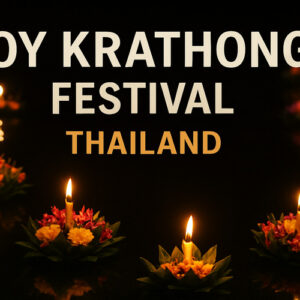

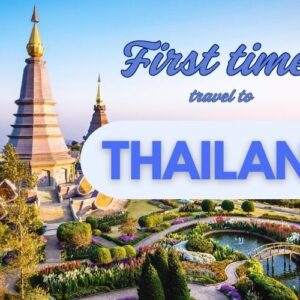

I’m a little confused, is Yi Peng the same as Loy Krathong or else?
Not exactly, though they happen at the same time! Loy Krathong is celebrated nationwide, where people float flower-decorated baskets (krathongs) on rivers. Yi Peng, on the other hand, is a northern tradition where thousands of lanterns are released into the sky. Chiang Mai is the only place where you can truly experience both together: one lighting up the sky, the other sparkling on the water.
Where’s the best place to celebrate: Chiang Mai, Sukhothai, or Bangkok?
It really depends on your travel vibe. Chiang Mai is vibrant, photogenic, and full of floating lanterns — perfect for first-timers or photographers. Sukhothai is more spiritual and traditional, with candlelit ruins that feel straight out of a dream. Bangkok is modern and convenient — easy transport, fancy dinner cruises, and plenty of hotel options. If you can only choose one, I highly recommend Chiang Mai, it’s very nice.